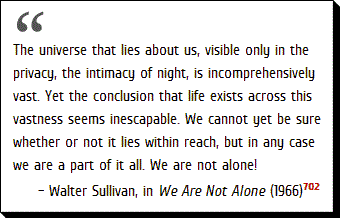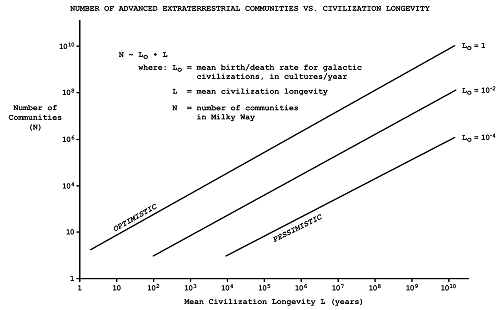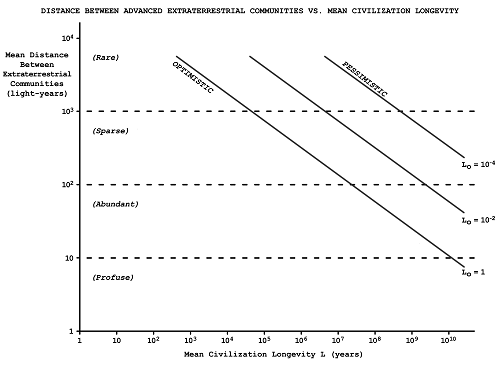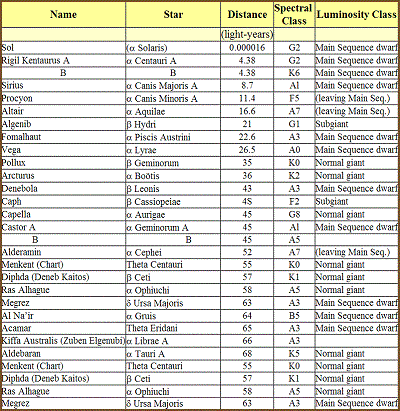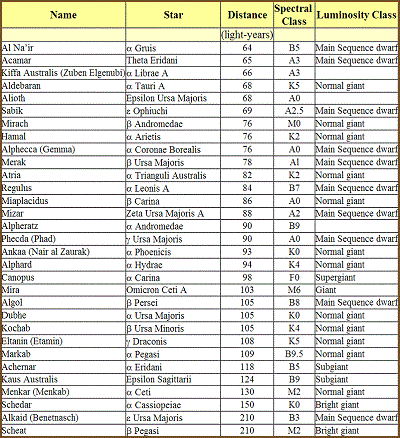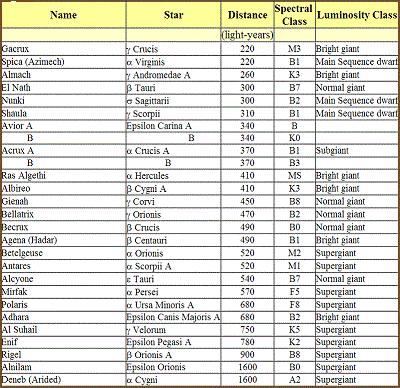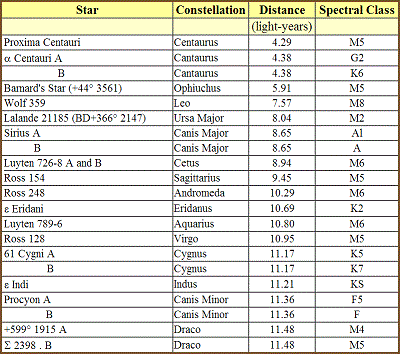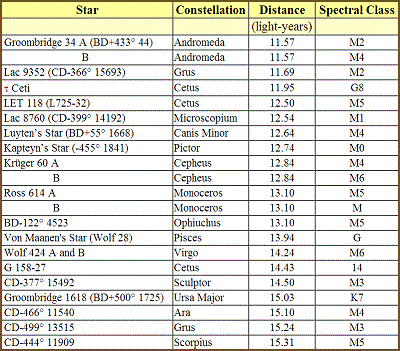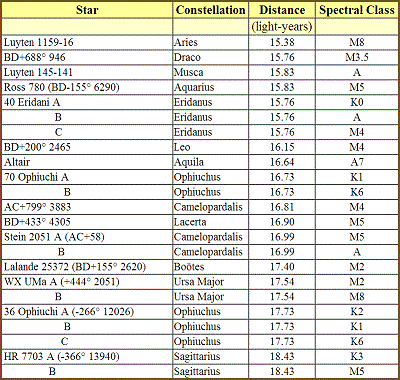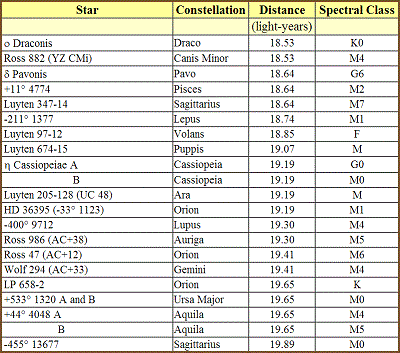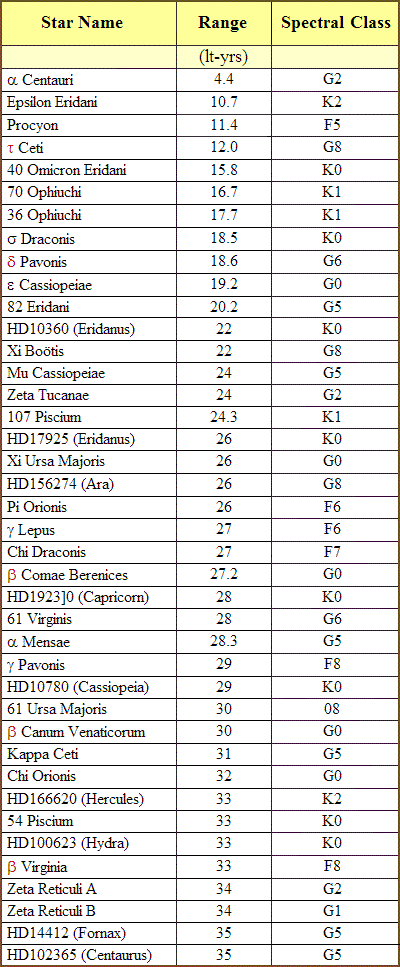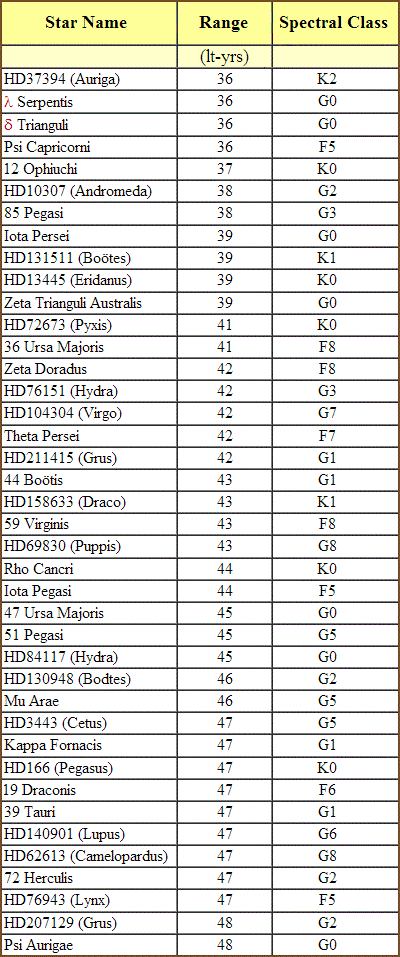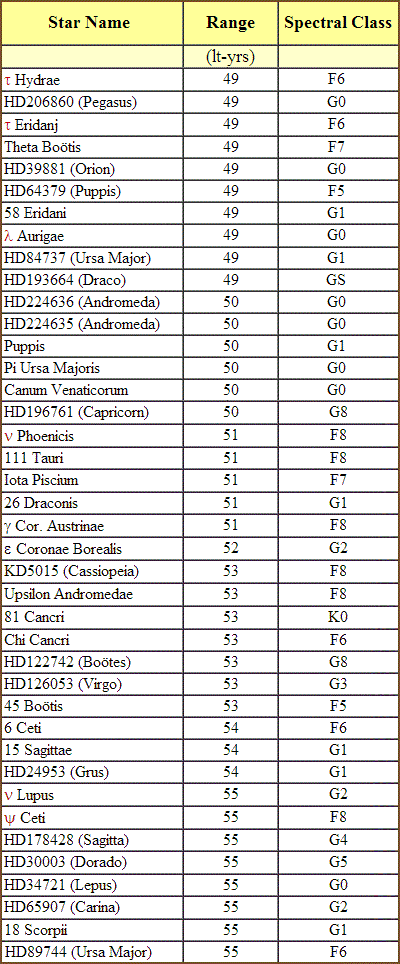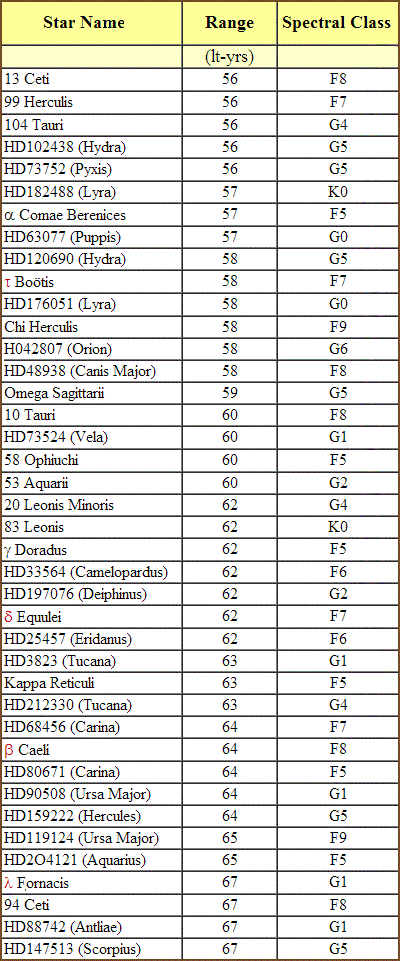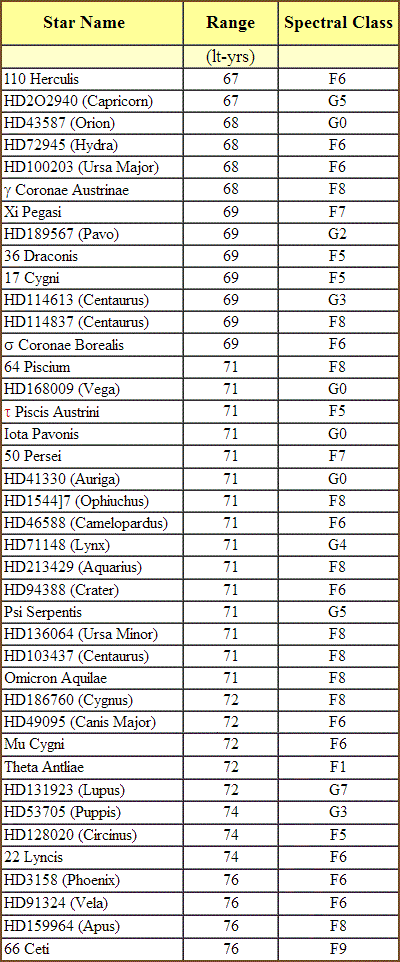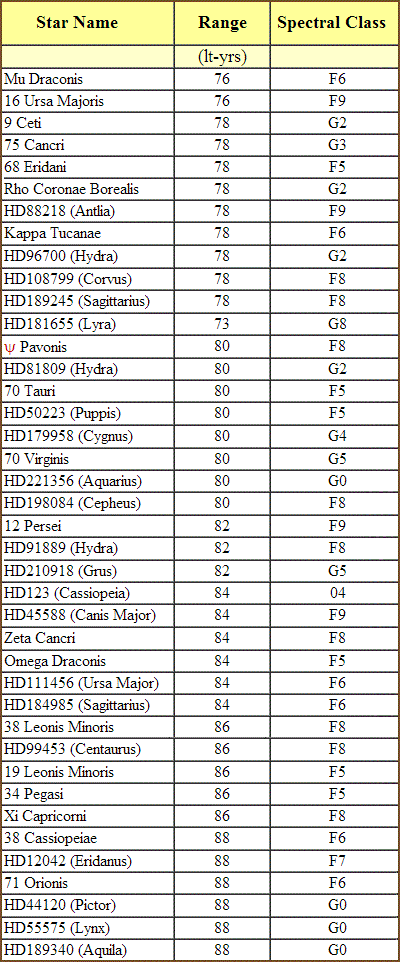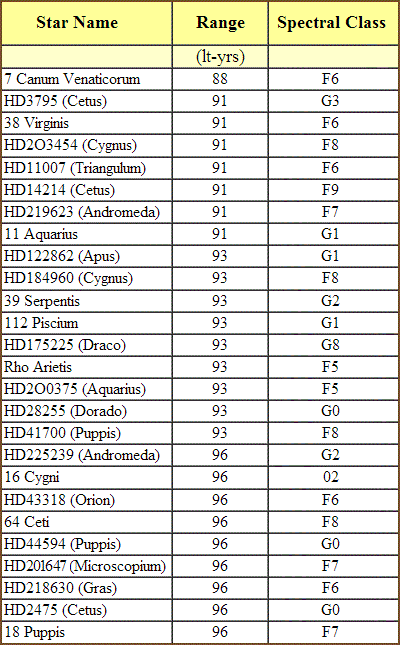© 1979 Robert A. Freitas Jr.
All Rights Reserved
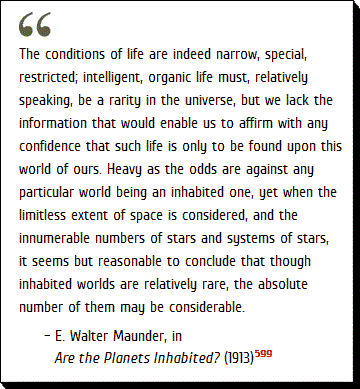 |
|
Such studies — sometimes
called Galactic Demographics by xenologists — are the primary concern of this brief introductory chapter. |
In previous chapters we have devoted much time to alternative alien biochemistries, physiologies, technologies, behaviors and cultural forms. Our discussion now turns from consideration of particular extraterrestrial races to the examination of the possibilities of interaction among them. When man meets alien, the human aspects of the event will be of monumental significance. Xenologists will be called upon to answer a number of very difficult questions.
| Difficult questions |
For instance:
- What is the optimum first contact procedure, both from the human standpoint and from the mutual perspective? How should we behave — and how shall we — when the fact of contact becomes widely known?
- What are the tradeoffs between physical security and the possibility of fantastic technological advancement and cultural enrichment?
- What is the best way to achieve understanding and community with a totally alien yet highly intelligent race of beings from another world, and what are the implications of their technology (or lack thereof)?
- Are there strong rationales for contacting other sentient species in the Galaxy?
- Why should They bother contacting us?
| Chances of first contact |
Before addressing these and many other fascinating issues, xenologists must consider a preliminary query: What are the chances that first contact ever will occur? In other words, is life, in general, distributed abundantly or sparsely throughout the cosmos? To answer this threshold question it is necessary to theorize in an informed manner upon the likelihood of extraterrestrial life, intelligence, and culture in our Galaxy, including its distribution and probable frequency. Much in the estimates which follow is highly speculative, but the methodology appears basically sound and yields a variety of curious results. (See especially Bond and Martin,3223 Bracewell,1041,80 Freeman and Lampton,1306 Hohlfeld and Terzian,2385 Kreifeldt,1263 Oliver and Billingham,57 Sagan,1317,22 Shklovskii and Sagan,20 Stull,3241 Sullivan,702 Tang,3087 von Hoerner,1054 and Wertz.1611)
Such studies — sometimes called Galactic Demographics by xenologists — are the primary concern of this brief introductory chapter.
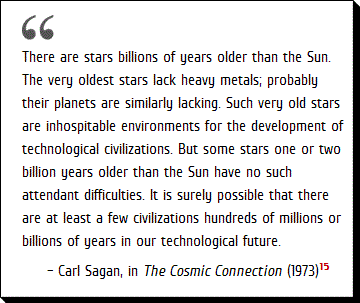 |
|
If this calculation
is correct, humanity is very much alone. |
The late Harlow Shapley was perhaps the first astronomer ever to seriously attempt quantitatively to estimate the frequency of extraterrestrial life in the universe.816 It is said that Shapley was more optimistic than his published estimates indicate, but that he deliberately chose extremely conservative numbers to forestall possible criticism from the scientific quarter. His calculation went something like this.
| The Shapley calculation |
- Suppose that only one star out of every 1000 has any planets at all.
- Further, let us presume that out of every 1000 worlds, only a single one is located an appropriate distance from its sun (and thus has a climate suitable for life).
- Then assume that out of all these well-placed planets only one in 1000 is big enough to hold an atmosphere, and that of these worlds, only one in 1000 has a chemical composition appropriate for the origin of life.
- Combining all of these factors, we find that only 1 star in 1012 is graced by life.
- There are at least 1021 stars in the universe so, according to Shapley, we may expect to find about 1,000,000,000 life sites in the cosmos.
|
Since the typical habitable galaxy has |
| One galaxy out of ten |
At first blush this seems like a very large number, but upon further reflection we see it is actually quite pessimistic. Since the typical habitable galaxy has about 1011 stars, only one galaxy out of ten will harbor any life at all. If this calculation is correct, humanity is very much alone.
| Shapley's cautious conservatism |
It appears that Shapley selected his step-factors of 1000 largely out of cautious conservatism without any real basis in genuine, established scientific findings. Subsequent formulations have been devised in an attempt to deal with this major failing of the Shapley calculation. The most popular alternative among xenologists today is the so-called Drake Equation1317 (or "Green Bank Formula"2358), named for its originator Frank D. Drake, a well-known American radioastronomer currently associated with the Center for Radio-physics and Space Research at Cornell University.
|
|
|
The Drake equation was developed to answer a specific and pragmatic question: How many advanced technical civilizations exist in our Galaxy, having both the interest and the ability to engage in interstellar communications of some kind? The earliest form of the Drake equation, much like the Shapley calculation, consists essentially of a string of probabilities that are multiplied together to achieve the final result.*
If N is the total number of communicative extraterrestrial civilizations, then, according to Drake:
- N = Nstar · fp · ne · fl · fi · fc
- Nstar= the number of stars in the Milky Way Galaxy which would be suitable suns for life-bearing planets;
- and
- fp = the fraction of these "good suns" actually having planetary systems;
- ne = number of planets with an environment suitable for life, per solar system;
- fl = the fraction of suitable planets on which life finally does arise;
- fi = the fraction of life-bearing worlds upon which intelligence appears;
- fc = the fraction of planets harboring intelligent creatures who go on
to develop the complex technology of interstellar communication.
| Skeptic's response |
Skeptics have wryly asserted that the Drake Equation is nothing more than a clever way to compress a large amount of ignorance into a very small space.
What values should we assign to these variables?
| Nstar value |
At the end of (Chapter 4), we concluded that about 5% of all stars in the Galaxy — roughly ten billion suns — should have characteristics suitable for the emergence of life. Most of these will lie in the Disk and the outer Core regions of the Milky Way. Hence we choose Nstar = 1010 "good suns."
| fp value |
What about fp? Astronomers now know that most stars are double or multiple.3260 Many "dark companions" have been confirmed, circling quite a few of the nearest stars, during the past century. There are numerous reports of possible planetary bodies (jovian-sized and larger) in orbit around a dozen or so of Sol’s stellar neighbors. In light of all the evidence, fp = 1 is probably reasonable.
| ne value |
How about ne? Based on the work of Dole and others, many astronomers believe that most single-star solar systems are likely to have from 7-13 major planetary bodies orbiting at various distances.1258,2714 Further, if we use our own system as an example of the typically exotic, we see that one out of nine planets has an environment suitable at least for our kind of life (carbon aqueous). So ne = 1 is certainly a plausible estimate. (Note that the possibility of lifeforms with alternative biochemistries merely serves to increase ne.) And recent studies of the origin of life on this planet seem to suggest that abiogenesis is virtually inevitable wherever a suitable environment exists, given enough time. There is wide spread agreement that setting fl = 1 cannot be too wide of the mark.
| fi and fc values |
What about the two remaining factors, fi and fc?
- Optimists generally assert that the development of intelligence is evolutionarily inevitable, since brains must serve the same negentropic master as the life process itself.
- In addition, they argue, intelligence begets society and society begets technology as population pressures mount and per capita resources dwindle.
- Under this view, fi = fc = 1.
Other scientists are not so sanguine about the inevitability of intelligence and culture.
- Human intellect has risen only in the last ~106 years, and culture in only perhaps ~105 years.
- This represents a mere 0.02% and 0.002%, respectively, of the total time life has existed on Earth.
- Maybe we’ve just been extraordinarily lucky, and conscious intelligence normally requires much more time to emerge.
- Or perhaps sentience usually fails to evolve at all before the local sun reaches the end of its life.
- And there are too many examples of technologically static and socially "arrested" cultures on Earth to ignore.
Scientists who have attempted to balance these conflicting "optimistic" and "pessimistic" viewpoints generally conclude that fi = 0.1 and = fc = 0.1 are not unreasonable numbers.3241
|
Table 23.1 Number of Stars, "Good Suns," and Intelligent Alien Races Within Radius R of Earth, using the Early Drake Equation Formulation |
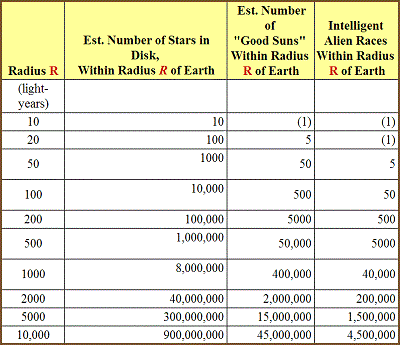 |
| One billion intelligent races |
Multiplying all six factors together gives:
- N = 1010 × 1 × 1 × 1 × 0.1 × 0.1 = 100,000,000 communicative technical civilizations in the Milky Way alone.
- Or, omitting the factor fc, we conclude that there may be as many as one billion intelligent alien races scattered throughout the Galaxy, each separated from the next by an average distance of 34 light-years.
Table 23.1 gives the estimated number of sentient extraterrestrial species expected to lie within a radius R of Earth.
| Dynamic version of the Drake Equation |
This simple form of the Drake Equation is static, however. It assumes that a communicative civilization, once formed, survives indefinitely. But all species eventually become extinct; even stars and galaxies eventually must die. Xenologists who work with the Drake Equation methodology prefer to include a dynamic component which takes account of the possible destruction of civilizations. This results in the "traditional" version of the Drake Equation, as follows:
- N = Rstar · fp · ne · fl · fi · fc · L
- Where Rstar is the mean rate of "good star" formation in the Galaxy
(1010 stars / 1010 years = 1.0 "good suns"/year) - And L is the average lifespan of a typical alien technical civilization.
Plugging in numbers as before, we find that:
- N = 1.0 × 1 × 1 × 1 × 0.1 × 0.1 × L = L/100.
- The mean lifetime of a civilization appears to be of critical significance in the calculation.
What do we do with L?
- Optimists may insist that technical cultures should be able to survive for 108 years.
- This corresponds roughly to the reign of the dinosaurs on Earth, and to the time ant society has persisted.
- There is no reason, argue the optimists, why humans and smart ETs could not do at least as well using the benefits of high technology.
- Accepting L = 108 years, then N = 1,000,000 sapient cultures in the Milky Way at the present time.
| Pessimistic viewpoint |
Pessimists point out that human technology is highly militaristic (and even that militarism may be necessary for the evolution of intelligence and technology3241).
- They note that the accumulated global destructive power today exceeds 10 tons of TNT (or its equivalent) per person.
- This may be viewed as a round ball of dynamite two meters in diameter hanging over the heads of every man, woman and child on Earth.22
- Initiation of global destruction rests in the hands of only a few dozen people, and the world military balance becomes more precarious with each passing decade.
- In the opinion of the pessimists, L may be on the order of decades, not eons. (Compare Berry77 and Viewing and Horswell3088 with Brown3272 and Hoyle.2998)
- Choosing the "generous" value of L = 102, the number of communicative civilizations extant in the Galaxy today falls to N = 1 (that is, us).85
|
The traditional Drake Equation may be written in the reduced form N = Lo L, where:
- Lo is the mean birth rate of new technical civilizations per annum in the Milky Way.
- Since deaths should equal births in a stable population, L may also be interpreted as the mean death rate of advanced societies. (Mathematically, Lo = Rstar · fp · ne · fl · fi · fc.)
- In the analysis above we found that N = L/100, or Lo = 10-2.
- An optimist, however, might choose Lo = 1 society/year, in which case N = L.
- A pessimist, on the other hand, might select Lo = 10-4 societies/year, which gives N = L/10,000.
- Once the xenologist has selected the cultural birth rate with which he feels most comfortable, both the number of extant technical communities and the average distance between them may be exactly determined.
- It is interesting to observe that only by making the most optimistic assumptions possible can we place the nearest advanced extraterrestrial civilization within 100 light-years of Earth.
(The results of choosing various ET community "turnover" rates are displayed on the graphs in Figure 23.1.)
| Improvements on the methodology |
Modern xenologists have made still further improvements on the methodology of galactic demography.57
- The traditional version of the Drake Equation uses a mean value for Rstar — the rate of formation of "good suns" in the Galaxy — which is averaged over the estimated 10 eon lifetime of the Milky Way.
- Yet astrophysicists recognize that the rate of star production from interstellar gases and dust has not held constant over time.
- Ten eons ago, the rate was perhaps two or three orders of magnitude higher than the mean; today, it is an order or two below.
- By taking this fact into account xenologists are more accurately able to calculate the number of alien civilizations which coexist (or have coexisted) in the Galaxy at any time t.
- In mathematical terms, the number N becomes the time-function N(t).
|
Figure 23.2 Population of Extraterrestrial Civlizations as a Function of Galactic Time(modified from Oliver1305) |
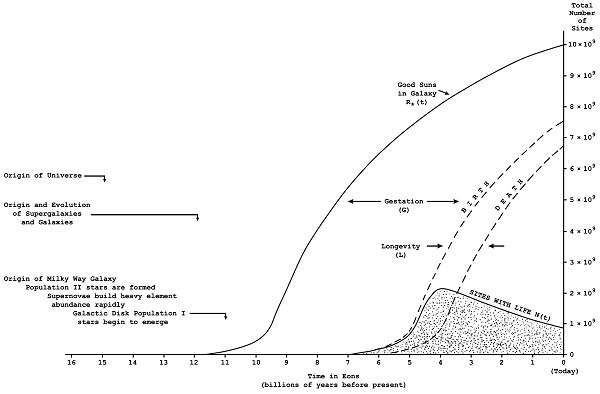 |
Consider the graph in Figure 23.2 at right.
- The leftmost curve, marked R*(t), represents the total number of solar systems suitable for the emergence of life as a function of galactic time. At each of these useful sites, xenobiologists tell us, life should originate within a few hundred million years.
- This event is then followed by a gestation time during which life and intelligence evolve, eventually resulting in the rise of a technical culture. For reasons that will become clear presently, we choose to set fi = fc = 1 (that is, Lo = 1) for the purposes of this calculation.
- In other words, we optimistically assume that every "good sun" eventually spawns an advanced alien civilization.
| Gestation time |
Applying the Hypothesis of Mediocrity and the example of Earth, xenologists believe that a good average value for the gestation time C should be on the order of that for human culture, about 4.5 × 109 years. Depending on local environmental conditions this quantity undoubtedly will vary considerably, but it seems that 4.5 eons is a reasonable mean or "expected" value.
| BIRTH to DEATH curve |
After the gestation period has elapsed, the number of sites in the Milky Way having communicative civilizations rapidly increases, following roughly the shape of the R*(t) curve. Later, when the average lifetime L of the typical technical culture has expired, extraterrestrial civilizations begin to die off along a curve parallel to the growth. (These two curves are labeled "BIRTH" and "DEATH" on the graph.) For reasons that will become apparent, we choose a very optimistic value for L of 109 years.
| Galactic population |
To obtain the Galactic population (the number of coexisting civilizations) at any given time t, galactic demographers simply subtract the death curve from the birth curve. The difference is the number of alien technical cultures which have been born but have not yet died at time t. On the graph this population curve is designated N(t).1305
| Humanity: a latecomer |
Perhaps the most fascinating result of this analysis is the size, shape and position of N(t).
- Apparently the population of coexistent technical civilizations peaked out about four billion years ago, when primeval ooze still slopped the rocky shores of ancient Earth.
- Humanity thus appears to be a latecomer on the cosmic stage — the majority of Galactic history has come and gone without us.442
- Seemingly, advanced life was more common in the past than it is now.57
- While there still exist a billion sites of life extant in the Milky Way today (50% of the peak reached 4 eons ago)
- There are some seven billion sites of extinct alien civilizations for starfaring archaeologists of the future to pore over.
- In other words, about 7 of every 8 technological alien cultures that have ever existed are extinct today.
It now becomes clear why we chose such optimistic values for fi - fc - and L.
| Choosing more conservative numbers |
Changing these numerical assumptions to more pessimistic values does not alter the sobering conclusion that humanity may have missed most of the Galactic action. For L, we’ve already selected as optimistic a figure as common sense will permit; smaller values merely serve to decrease the galactic population overall and to shift the peak of N(t) further back in time. Choosing more conservative numbers for and in the Drake Equation has a similar effect. In fact, only by positing an unreasonably lengthy mean gestation time plus mean lifetime (G + L) greater than 12 billion years can demographers arrange for humanity to sit on the rising side of the curve representing the civilized population of the Galactic community.
 |
Where might we expect to find alien life and civilization in nearby extrasolar space?
The following three tables may serve as starting points for discussions of this speculative question.
Due to unavoidably deficient data, Table 23.4 is complete only out to about 40 light-years. From 40-100 light-years, data are available only for about 25% of the "good suns" expected to lie at this range. The deficiency is almost exclusively among the class K stars (which are harder to measure at great distances) beyond 40 light-years, although many late class G suns are also missing beyond 50-60 light-years.
|
Table 23.2 lists the 75 brightest named stars in the night sky of Earth. Table 23.3 gives a complete inventory of all luminous stars within 20 light-years of Sol. Table 23.4 includes a listing of all "good suns"* within 100 light-years (30 parsecs) of Sol. |
|
|
* In this context, a "good sun" is a Main Sequence dwarf (Sol-like) belonging to stellar classes F5-K2. The nearest to Sol is the α Centauri star system,3089 which recently has been discovered to be 6 eons old and significantly richer in heavy elements than our own solar system.3224
|
Table 23.5 Possible Planetary Companions of Nearby Stars |
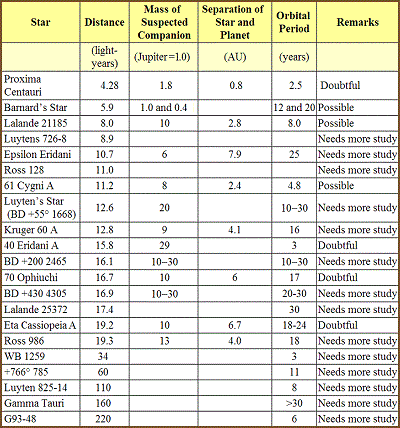 |
Assuming habitable worlds circle some or all of these distant stars, how might they be detected from Earth? There are four basic techniques, none of which has as yet provided absolutely unambiguous evidence for the existence of extrasolar planets.* The present state of the data is summarized in Table 23.5, at right.
| Technique of astrometry |
Certainly the most fruitful approach to date has been the technique of astrometry.
This requires a bit of explanation.
- It will be recalled that all stars in the Milky Way orbit the galactic center much as planets circle a sun.
- Since each star moves with a slightly different velocity, celestial objects appear slowly to change position relative to each other over the years.
- Slowly, inexorably, the familiar constellations are torn asunder as the component stars move off in different directions at different speeds.
- For instance, the stars Sirius, Betelgeuse, Aldebaran and Arcturus have moved about the apparent diameter of the moon (Luna) since Ptolemy mapped them two millennia ago.
- The path traced in the sky by a wandering star is referred to as its "proper motion" by astronomers.
| Invisible companion bodies |
A lone sun traces a straight path across the sky, but a star with a retinue of invisible companion bodies should wobble slightly as it traverses the celestial vault. This is because the presence of the unseen planetary masses shifts the center of mass away from the center of the sun.
- The star, like its planets, actually circles this center of mass, which distant observers may observe as a tiny sinusoidal wobble with a period on the order of decades.
- Astrometry is a form of careful positional measurement which allows astronomers to calculate the mass and orbit of the hidden worlds based on the amplitude and frequency of wobble in the proper motion of the target star.
| Accurate measurements |
Imagine an hypothetical alien astronomer located 10 parsecs (33 light-years) away who wishes to demonstrate the existence of planets around Sol using astrometry. How accurate must his measurements be?
|
A minute of arc, or arcminute is
|
- Viewed from this distant observatory, our sun would subtend only 10-3 arcsec (seconds of arc, or 1/3600 of a degree) in the sky.
- One-half an arcsec away from this minute yellow disk is found the giant planet Jupiter, a shining pinprick of light 10-4 arcsec in diameter.
| Perspective on extremely high accuracy |
It is helpful to put these numbers into proper perspective in order to fully appreciate their smallness.
A second of arc is considered extremely high accuracy in all normal circumstances.
- One arcsec is the equivalent of hitting a buzzing horsefly with a rifle bullet at a range of 2 kilometers.
- But Sol would subtend only 10-3 arcsec, which is like hitting the same horsefly in New Orleans by firing a rifle in Los Angeles (more than 2000 kilometers).
- To use another example, consider a level tabletop. When you touch it lightly, it tilts by at least a second of arc.
- At the 10-3 arcsec level the table is like the surface of a sea — acoustic waves from people talking wash back and forth across its surface and "tilt" it by more than milliseconds of arc.
- To observe Sol’s wobble due to Jupiter, our hypothetical ET astronomer would have to be able to measure variations in proper motion of about arcsec at a range of 10 parsecs.
- The displacement of our sun due to the presence of Earth is considerably smaller, less than 10-6 arcsec at 10 parsecs.
- The state-of-the-art of astrometric precision was roughly 3 × 10-3 arcsec for human technology in the mid-1970s, which means that mankind is now at the threshold of the capacity to detect jovian planets circling neighboring stars.2200
- Scientists believe that sophisticated interferometric techniques2387 can increase ground-based accuracy to 50 × 10-6 arcsec, and that large spaceborne telescopes specially designed for the task can reach 10-6 arcsec accuracies.3092,2865 (NASA’s 2.4-meter Space Telescope has pointing stability of 0.007 arcsec.)
| Difficulties with astrometry |
|
It is helpful to put these numbers A second of arc is extremely high One arcsec is the equivalent of hitting Sol would subtend only 10-3 arcsec, |
The major difficulty with astrometry is that several cycles of the alien planet must be observed to identify and validate a discovery, which means several decades’ worth of data must be accumulated. Furthermore, the presence of more than one perturbing planetary body (Sol has 9) greatly complicates the mathematical analysis of periodicities in the wobble in proper motion of the target star.
To date, only astrometry has been exploited in the search for extrasolar worlds. But three other promising techniques have been discussed at length in scientific circles. The first of these is called the spectroscopic or "radial velocity" method.
| Spectroscopic method |
Whereas proper motion is the apparent movement of a star across the sky, stellar "radial motion" is its velocity towards or away from us. We recall that light emitted from a moving object undergoes a Doppler shift in wavelength depending on the relative velocity of source and observer.
- By measuring the Doppler shift in a star’s visual spectrum, astronomers are able to determine its radial velocity.
- If a massive planet is present, then its orbit will cause the star’s radial velocity to oscillate much like the wobble in proper motion discussed in connection with astrometry.
- Rather than a positional undulation, however, the planet-hunting spectroscopist is looking for minute cyclical variations in Doppler-shifted starlight.
- This requires an instrument accurate to 0.08 mm visible light, able to detect variations in radial velocity on the order of 5 meters/second.1568
- To date, the most sophisticated equipment has accuracies about an order of magnitude too low, but astronomers estimate that the state-of-the-art should progress enough in a decade or two to make the spectroscopic method feasible.2865
| Photometry |
Photometry is another promising technique.
- If the orbital plane of the target solar system happens to lie precisely in our line of sight, then at some point planets will cross the face of the star and partially eclipse its light.
- If a planet the size of Jupiter crossed in front of a star like Sol, the decrease in brightness would amount to about 1% change in total luminosity. (Passage of Earth would only cause a minute 0.008% eclipse, and so on.1259)
- Astronomers believe that the colorimetric and photometric eclipse signature should be fairly easy to detect and to identify.1266
- One writer has calculated the probability of the onset or termination of an eclipse by any one of Sol's planets during a typical 6-hour observation period (a single night’s work at the telescope).
- For a randomly situated extraterrestrial observer, using the techniques proposed, the expected detection rate could be as high as one new solar system per year.
- About one star in a hundred should have a line of sight close enough to the orbital plane around Sol to allow all four of our inner planets to be detected by alien astronomers.**1259
- Human astronomers should prove equally lucky.
| Direct observation |
The third most promising method for spotting other worlds is direct observation.
There are two main difficulties involved in this.
First there is the problem of optical resolution.
- Seen from 10 parsecs away, Sol and Jupiter appear only 0.5 arcsec apart — close to the limits of present-day ground-based telescopes.
- And planets smaller than Jupiter at the same distance, or jovian worlds farther from the star, probably could not be resolved using present instrumentation.
- The image of the star and planet would blur together.
The second main difficulty is that the extrasolar body we seek is very faint.
- Shining in reflected light, the luminosity of the planet is only about 10-8 that of the stellar primary in the visible wavelengths.
- Dr. Bernard Oliver of the Hewlett-Packard Corporation has estimated that sophisticated "apodization" techniques (a mask fitted over the end of the telescope to selectively reduce the brightness of the star’s diffraction pattern) could be used in a 2-meter spaceborne telescope which would just barely permit a jovian world to be resolved.2865
- Indeed the Space Telescope, due to be launched by NASA in the early 1980’s, should fulfill these requirements and permit the first direct imaging of extrasolar planets.2103
Another solution to the problem is to shift to lower frequencies where the star is relatively less bright.
- For example, in the infrared the luminosity differential falls from 10-8 to 10-4.2865
- In the radio things are even better: Fennelly and Matloff have estimated that jovian planets may be detectable out to 10 parsecs using intercontinental interferometry at radio wavelengths.1453
Ultimately it would be nice to be able to take detailed color photographs of terrestrial worlds across interstellar distances. Is this possible?***
| Spaceborne occulter apparatus |
Lyman J. Spitzer, Director of the Princeton University Observatory, has proposed a spaceborne occulter apparatus.3080
- In this scheme, an orbiting large space telescope is pointed at the target star.
- A disk of black material is then placed in the instrument’s field of view in such a way that it exactly covers up the image of the star.
- The blazing brilliance of the primary is blotted out, permitting the detection of much fainter planetary bodies.
- According to Spitzer, NASA’s Space Telescope should suffice to resolve a jovian 10 parsecs away if an occulting disk 75 meters wide is placed 10,000 kilometers in front of the telescope.
- To spot an Earthlike extrasolar world at the same distance, a 400-meter-wide disk must be accurately positioned 250,000 kilometers ahead of the telescope.
- Citing the practical problems inherent in such a proposal, a few authors have advocated using Luna as an occulter.3189,1095
- To pick out jovians at 10 parsecs, a 3-meter space telescope should be placed in a near-polar 8100-km-high lunar orbit.
- The curved limb of the moon periodically would blot out the star light, making possible at least minute-long observations of reflected extrasolar planet light.
- To spot Earthlike worlds, a 7-meter space telescope should be placed in high Earth orbit, again using the distant Luna as an occulter.
| Huge multi-mirror arrays |
Still larger systems could actually begin to resolve features on the surfaces of these faraway celestial bodies. The possibility of constructing orbital and lunar telescopes comprised of giant mirrors or huge multi-mirror arrays has been discussed in the literature.3091,3085 According to Gerard O’Neill, the fabrication of large space structures should make interstellar imaging a snap:
- It might be preferable to take advantage of a zero-gravity location by building a large number — perhaps 10,000 — of individual glass mirrors, each a meter in diameter, and providing each with a small locator-module, equipped with station-keeping gas jets.
- If the 10,000 elements were linked only by light beams, their spacing could be established by the unvarying number of wavelengths of light between each pair.
- That nonphysical linkage, computer-controlled, would have the further advantage that the mirrors could be programmed to separate and reform, like dancers in a slow-motion ballet. … If located in a cross-shaped array, with individual elements spaced ten meters apart, a telescope of that kind would have the theoretical capability of resolving something as small as a changing weather system, one thousand kilometers on a side — on the planet of a star ten light-years away.2710
* See reviews by Gatewood,1567 Huang,1278 Martin1452,1088,1092 Matloff and Fennelly,1614 Morrison, Billingham, and Wolfe,2865 O’Leary,1244 and Smith.2866
| Variation of the photometric method |
** Edward Argyle at the Dominion Radio Astrophysical Observatory in Canada has proposed a clever variation of the photometric method. Planets shine with reflected light and are located several light-minutes from the source of illumination (the star). If the emitted starlight varies, the portion reflected by the planet will be delayed in time behind the rest of the solar output. Careful photometric measurement, says Argyle, should permit the separation of these "light-echoes" from the normal starlight, thus demonstrating the presence of reflective planetary bodies and proving the existence theorem for extrasolar worlds.1289
| Giant red star Betelgeuse |
*** The surface of Betelgeuse, the giant red star in the constellation Orion, has been successfully photographed using computer-enhanced "speckle interferometry" techniques.411,3090 Surface structures are clearly visible in the photos.
